Change Management Strategies: Overcoming Employee Resistance
VerifiedAdded on 2020/01/07
|9
|2783
|152
Report
AI Summary
This report delves into the critical aspects of change management within organizations, emphasizing the importance of effectively managing employee resistance. It explores the drivers of change, including competition, technological advancements, and the desire for growth, using Samsung as a case study. The report highlights various strategies for mitigating resistance, such as clear communication, employee involvement, understanding and addressing concerns, fostering a collaborative organizational culture, and gathering feedback. It also discusses the application of the Kurt Lewin change model (Unfreeze-Transition-Refreeze) and the significance of motivational and leadership strategies in facilitating successful change implementation. Furthermore, it underscores the importance of analyzing and mitigating risks associated with change initiatives, ultimately providing valuable insights for organizations seeking to navigate change effectively and achieve their strategic goals.
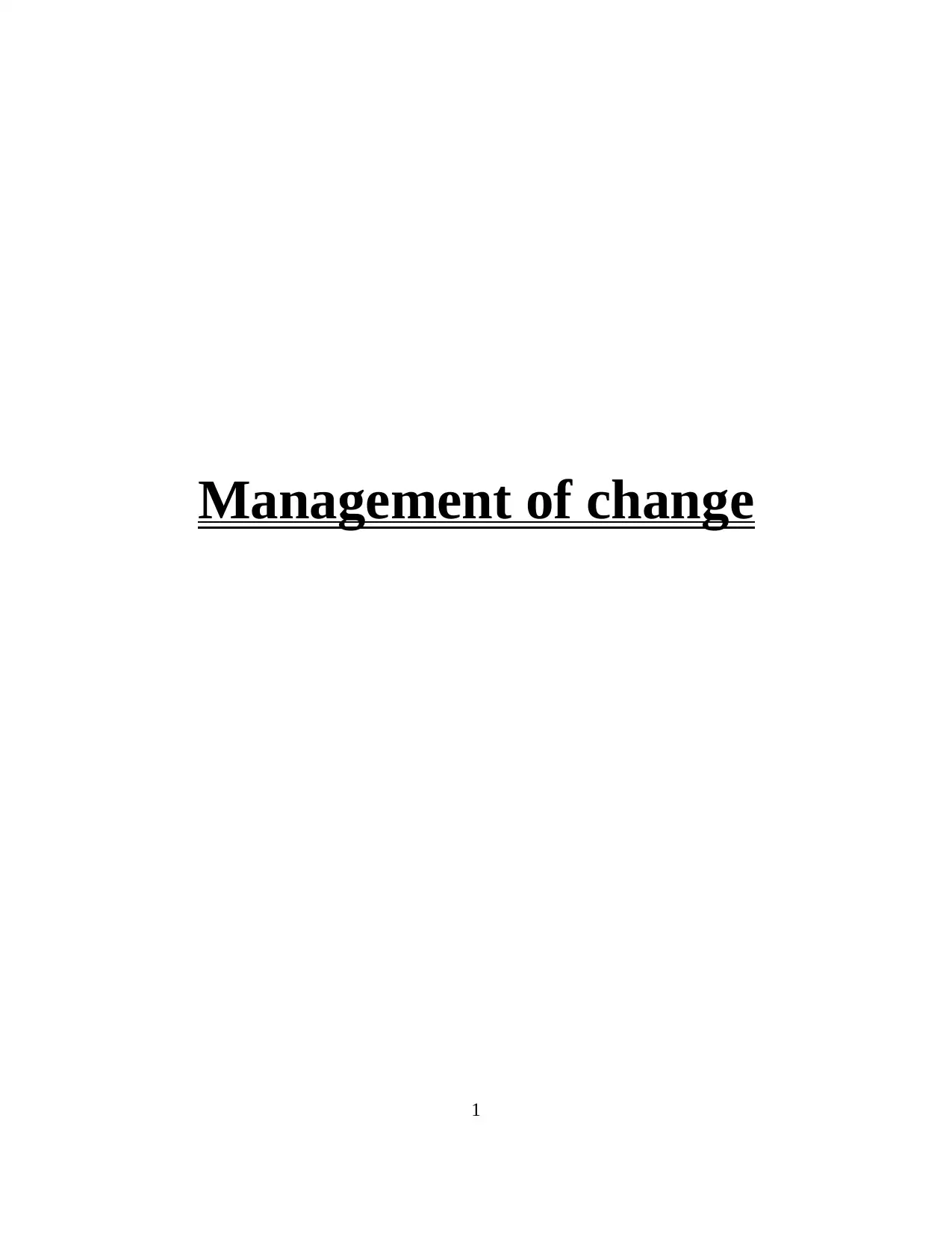
Management of change
1
1
Paraphrase This Document
Need a fresh take? Get an instant paraphrase of this document with our AI Paraphraser
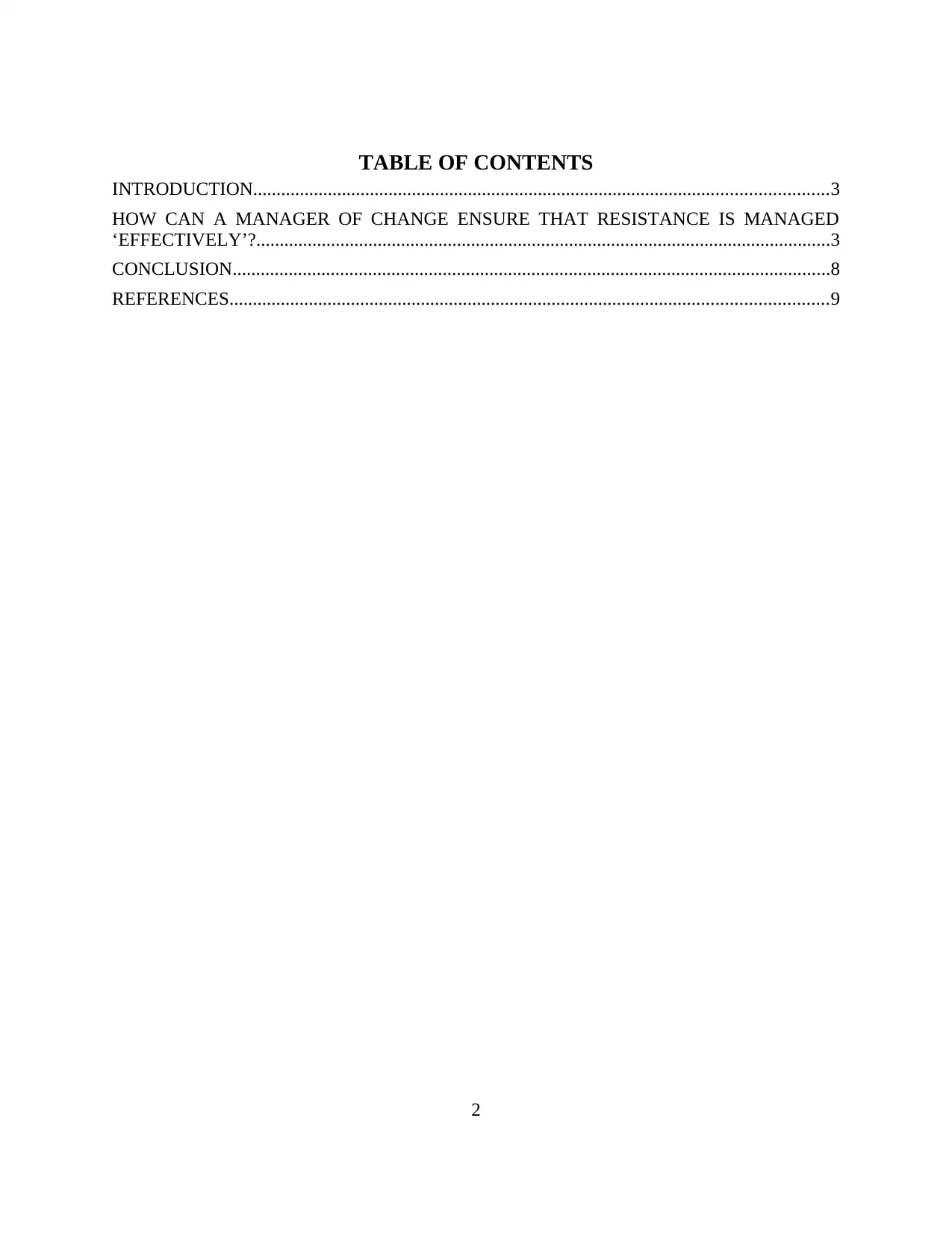
TABLE OF CONTENTS
INTRODUCTION...........................................................................................................................3
HOW CAN A MANAGER OF CHANGE ENSURE THAT RESISTANCE IS MANAGED
‘EFFECTIVELY’?...........................................................................................................................3
CONCLUSION................................................................................................................................8
REFERENCES................................................................................................................................9
2
INTRODUCTION...........................................................................................................................3
HOW CAN A MANAGER OF CHANGE ENSURE THAT RESISTANCE IS MANAGED
‘EFFECTIVELY’?...........................................................................................................................3
CONCLUSION................................................................................................................................8
REFERENCES................................................................................................................................9
2
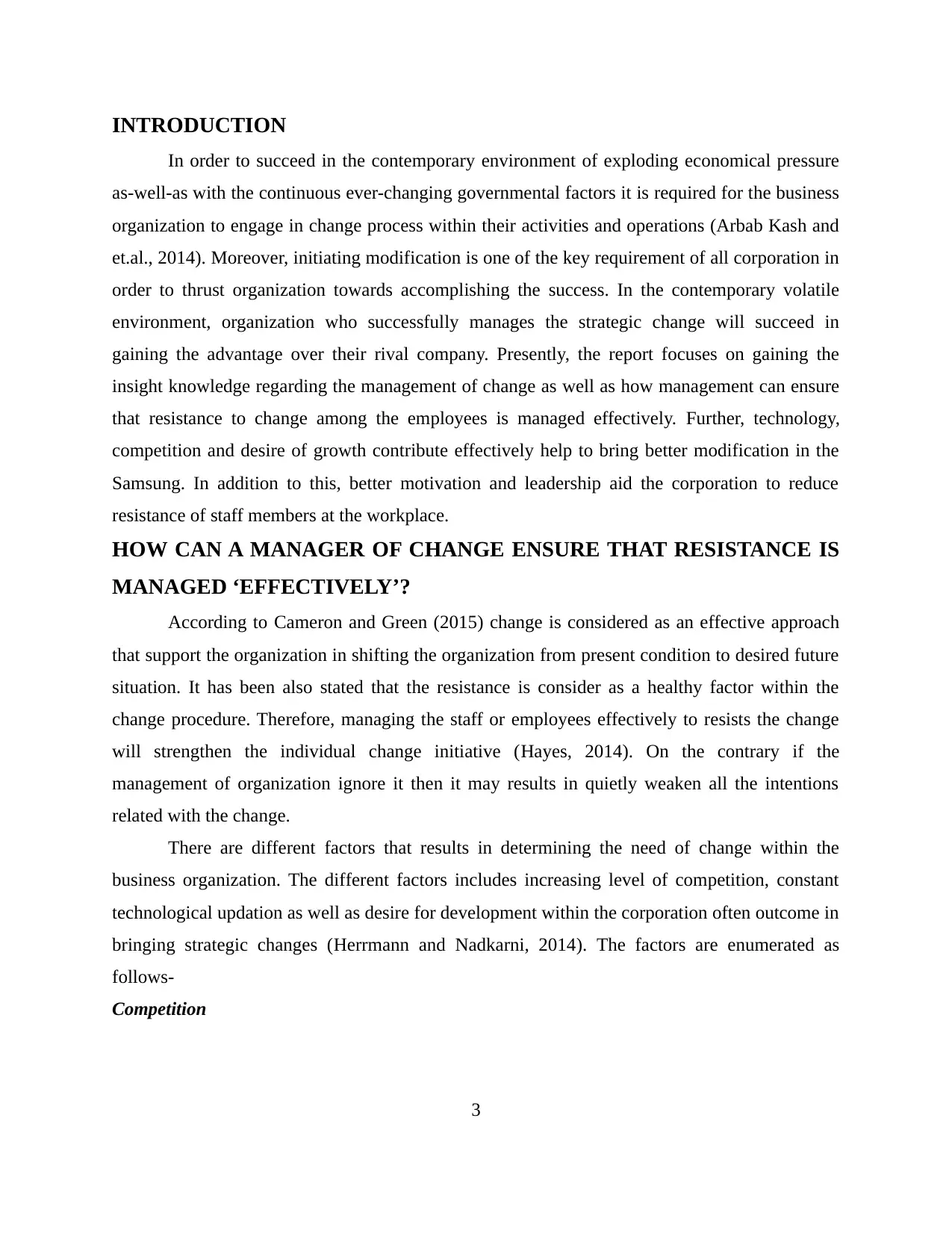
INTRODUCTION
In order to succeed in the contemporary environment of exploding economical pressure
as-well-as with the continuous ever-changing governmental factors it is required for the business
organization to engage in change process within their activities and operations (Arbab Kash and
et.al., 2014). Moreover, initiating modification is one of the key requirement of all corporation in
order to thrust organization towards accomplishing the success. In the contemporary volatile
environment, organization who successfully manages the strategic change will succeed in
gaining the advantage over their rival company. Presently, the report focuses on gaining the
insight knowledge regarding the management of change as well as how management can ensure
that resistance to change among the employees is managed effectively. Further, technology,
competition and desire of growth contribute effectively help to bring better modification in the
Samsung. In addition to this, better motivation and leadership aid the corporation to reduce
resistance of staff members at the workplace.
HOW CAN A MANAGER OF CHANGE ENSURE THAT RESISTANCE IS
MANAGED ‘EFFECTIVELY’?
According to Cameron and Green (2015) change is considered as an effective approach
that support the organization in shifting the organization from present condition to desired future
situation. It has been also stated that the resistance is consider as a healthy factor within the
change procedure. Therefore, managing the staff or employees effectively to resists the change
will strengthen the individual change initiative (Hayes, 2014). On the contrary if the
management of organization ignore it then it may results in quietly weaken all the intentions
related with the change.
There are different factors that results in determining the need of change within the
business organization. The different factors includes increasing level of competition, constant
technological updation as well as desire for development within the corporation often outcome in
bringing strategic changes (Herrmann and Nadkarni, 2014). The factors are enumerated as
follows-
Competition
3
In order to succeed in the contemporary environment of exploding economical pressure
as-well-as with the continuous ever-changing governmental factors it is required for the business
organization to engage in change process within their activities and operations (Arbab Kash and
et.al., 2014). Moreover, initiating modification is one of the key requirement of all corporation in
order to thrust organization towards accomplishing the success. In the contemporary volatile
environment, organization who successfully manages the strategic change will succeed in
gaining the advantage over their rival company. Presently, the report focuses on gaining the
insight knowledge regarding the management of change as well as how management can ensure
that resistance to change among the employees is managed effectively. Further, technology,
competition and desire of growth contribute effectively help to bring better modification in the
Samsung. In addition to this, better motivation and leadership aid the corporation to reduce
resistance of staff members at the workplace.
HOW CAN A MANAGER OF CHANGE ENSURE THAT RESISTANCE IS
MANAGED ‘EFFECTIVELY’?
According to Cameron and Green (2015) change is considered as an effective approach
that support the organization in shifting the organization from present condition to desired future
situation. It has been also stated that the resistance is consider as a healthy factor within the
change procedure. Therefore, managing the staff or employees effectively to resists the change
will strengthen the individual change initiative (Hayes, 2014). On the contrary if the
management of organization ignore it then it may results in quietly weaken all the intentions
related with the change.
There are different factors that results in determining the need of change within the
business organization. The different factors includes increasing level of competition, constant
technological updation as well as desire for development within the corporation often outcome in
bringing strategic changes (Herrmann and Nadkarni, 2014). The factors are enumerated as
follows-
Competition
3
⊘ This is a preview!⊘
Do you want full access?
Subscribe today to unlock all pages.

Trusted by 1+ million students worldwide
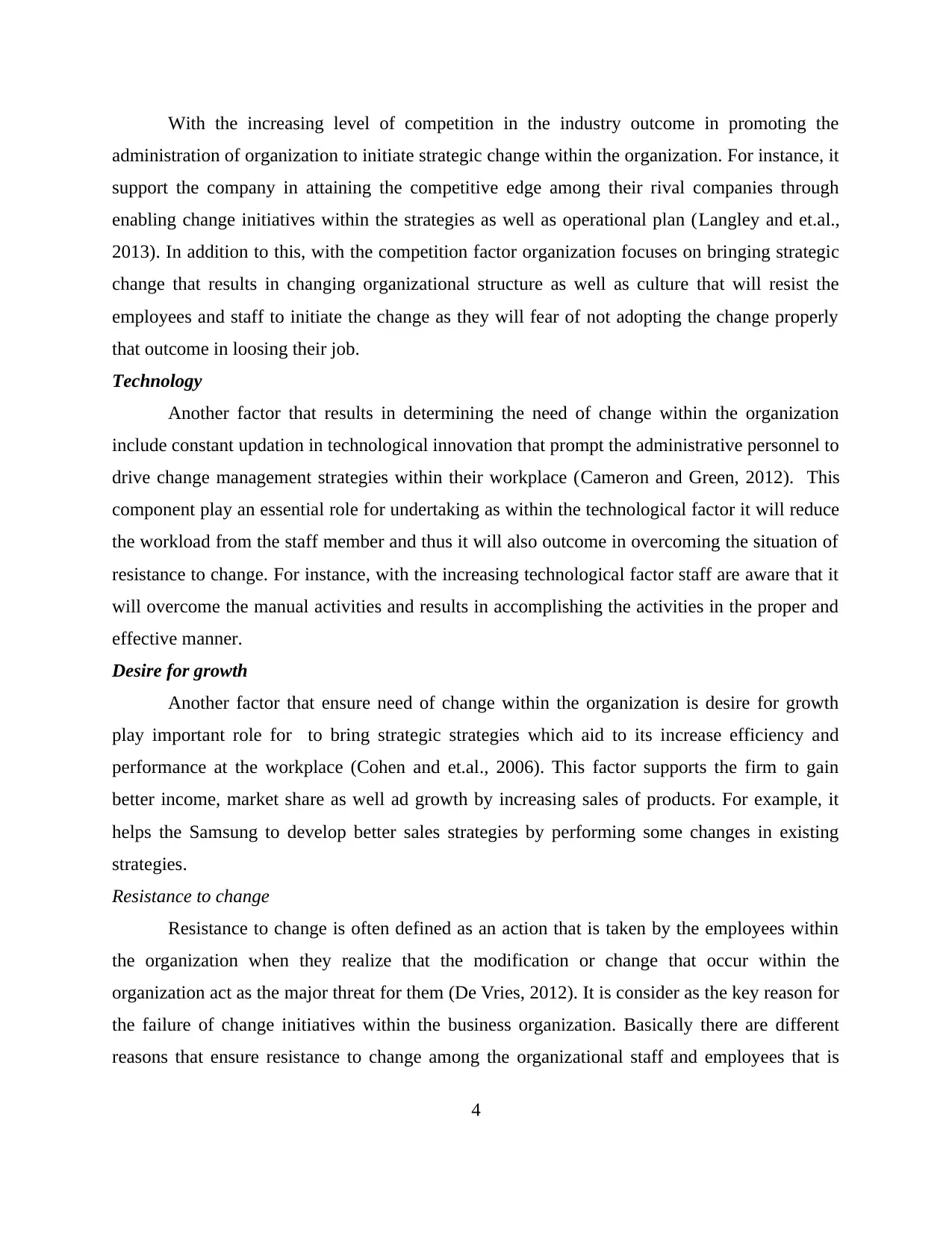
With the increasing level of competition in the industry outcome in promoting the
administration of organization to initiate strategic change within the organization. For instance, it
support the company in attaining the competitive edge among their rival companies through
enabling change initiatives within the strategies as well as operational plan (Langley and et.al.,
2013). In addition to this, with the competition factor organization focuses on bringing strategic
change that results in changing organizational structure as well as culture that will resist the
employees and staff to initiate the change as they will fear of not adopting the change properly
that outcome in loosing their job.
Technology
Another factor that results in determining the need of change within the organization
include constant updation in technological innovation that prompt the administrative personnel to
drive change management strategies within their workplace (Cameron and Green, 2012). This
component play an essential role for undertaking as within the technological factor it will reduce
the workload from the staff member and thus it will also outcome in overcoming the situation of
resistance to change. For instance, with the increasing technological factor staff are aware that it
will overcome the manual activities and results in accomplishing the activities in the proper and
effective manner.
Desire for growth
Another factor that ensure need of change within the organization is desire for growth
play important role for to bring strategic strategies which aid to its increase efficiency and
performance at the workplace (Cohen and et.al., 2006). This factor supports the firm to gain
better income, market share as well ad growth by increasing sales of products. For example, it
helps the Samsung to develop better sales strategies by performing some changes in existing
strategies.
Resistance to change
Resistance to change is often defined as an action that is taken by the employees within
the organization when they realize that the modification or change that occur within the
organization act as the major threat for them (De Vries, 2012). It is consider as the key reason for
the failure of change initiatives within the business organization. Basically there are different
reasons that ensure resistance to change among the organizational staff and employees that is
4
administration of organization to initiate strategic change within the organization. For instance, it
support the company in attaining the competitive edge among their rival companies through
enabling change initiatives within the strategies as well as operational plan (Langley and et.al.,
2013). In addition to this, with the competition factor organization focuses on bringing strategic
change that results in changing organizational structure as well as culture that will resist the
employees and staff to initiate the change as they will fear of not adopting the change properly
that outcome in loosing their job.
Technology
Another factor that results in determining the need of change within the organization
include constant updation in technological innovation that prompt the administrative personnel to
drive change management strategies within their workplace (Cameron and Green, 2012). This
component play an essential role for undertaking as within the technological factor it will reduce
the workload from the staff member and thus it will also outcome in overcoming the situation of
resistance to change. For instance, with the increasing technological factor staff are aware that it
will overcome the manual activities and results in accomplishing the activities in the proper and
effective manner.
Desire for growth
Another factor that ensure need of change within the organization is desire for growth
play important role for to bring strategic strategies which aid to its increase efficiency and
performance at the workplace (Cohen and et.al., 2006). This factor supports the firm to gain
better income, market share as well ad growth by increasing sales of products. For example, it
helps the Samsung to develop better sales strategies by performing some changes in existing
strategies.
Resistance to change
Resistance to change is often defined as an action that is taken by the employees within
the organization when they realize that the modification or change that occur within the
organization act as the major threat for them (De Vries, 2012). It is consider as the key reason for
the failure of change initiatives within the business organization. Basically there are different
reasons that ensure resistance to change among the organizational staff and employees that is
4
Paraphrase This Document
Need a fresh take? Get an instant paraphrase of this document with our AI Paraphraser
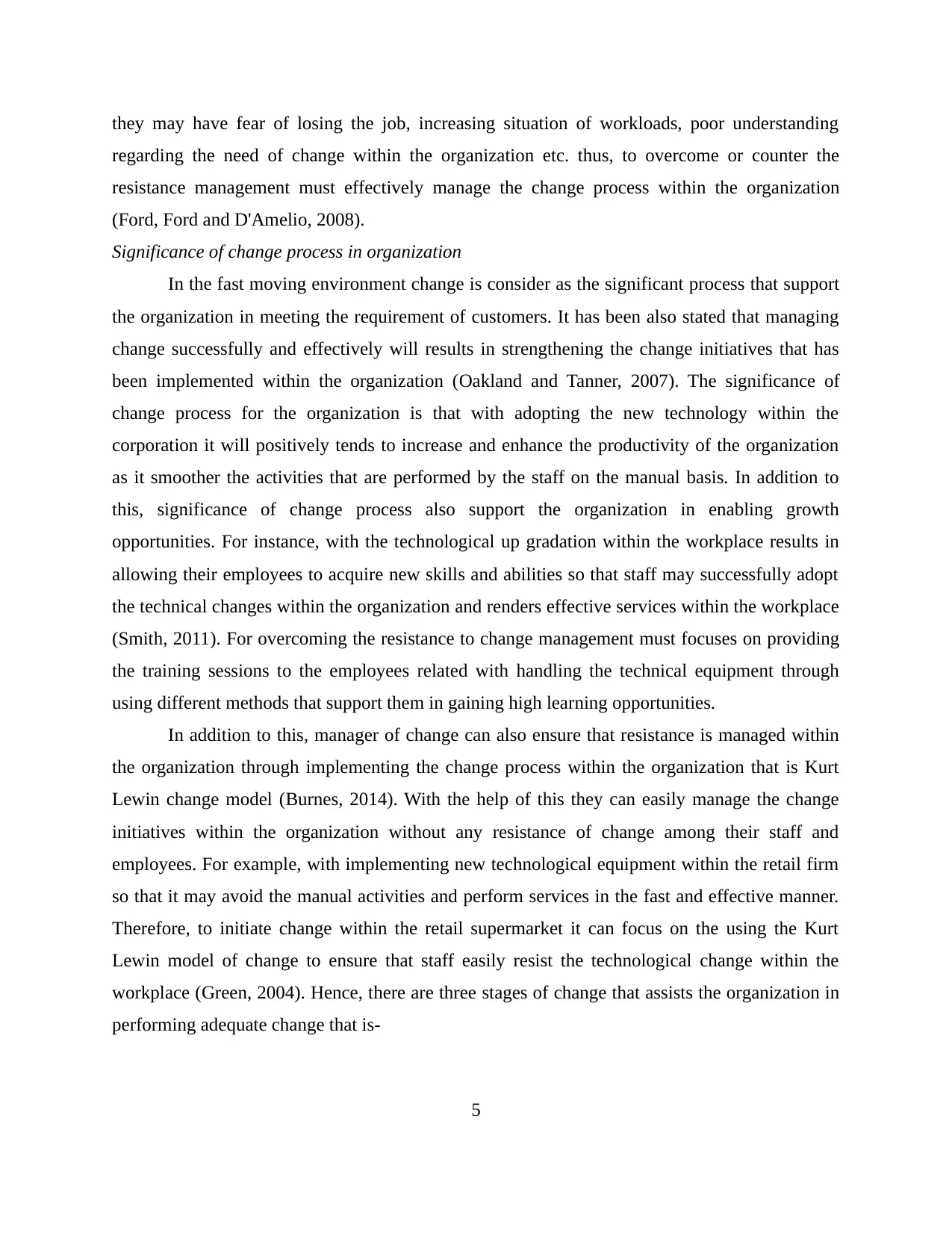
they may have fear of losing the job, increasing situation of workloads, poor understanding
regarding the need of change within the organization etc. thus, to overcome or counter the
resistance management must effectively manage the change process within the organization
(Ford, Ford and D'Amelio, 2008).
Significance of change process in organization
In the fast moving environment change is consider as the significant process that support
the organization in meeting the requirement of customers. It has been also stated that managing
change successfully and effectively will results in strengthening the change initiatives that has
been implemented within the organization (Oakland and Tanner, 2007). The significance of
change process for the organization is that with adopting the new technology within the
corporation it will positively tends to increase and enhance the productivity of the organization
as it smoother the activities that are performed by the staff on the manual basis. In addition to
this, significance of change process also support the organization in enabling growth
opportunities. For instance, with the technological up gradation within the workplace results in
allowing their employees to acquire new skills and abilities so that staff may successfully adopt
the technical changes within the organization and renders effective services within the workplace
(Smith, 2011). For overcoming the resistance to change management must focuses on providing
the training sessions to the employees related with handling the technical equipment through
using different methods that support them in gaining high learning opportunities.
In addition to this, manager of change can also ensure that resistance is managed within
the organization through implementing the change process within the organization that is Kurt
Lewin change model (Burnes, 2014). With the help of this they can easily manage the change
initiatives within the organization without any resistance of change among their staff and
employees. For example, with implementing new technological equipment within the retail firm
so that it may avoid the manual activities and perform services in the fast and effective manner.
Therefore, to initiate change within the retail supermarket it can focus on the using the Kurt
Lewin model of change to ensure that staff easily resist the technological change within the
workplace (Green, 2004). Hence, there are three stages of change that assists the organization in
performing adequate change that is-
5
regarding the need of change within the organization etc. thus, to overcome or counter the
resistance management must effectively manage the change process within the organization
(Ford, Ford and D'Amelio, 2008).
Significance of change process in organization
In the fast moving environment change is consider as the significant process that support
the organization in meeting the requirement of customers. It has been also stated that managing
change successfully and effectively will results in strengthening the change initiatives that has
been implemented within the organization (Oakland and Tanner, 2007). The significance of
change process for the organization is that with adopting the new technology within the
corporation it will positively tends to increase and enhance the productivity of the organization
as it smoother the activities that are performed by the staff on the manual basis. In addition to
this, significance of change process also support the organization in enabling growth
opportunities. For instance, with the technological up gradation within the workplace results in
allowing their employees to acquire new skills and abilities so that staff may successfully adopt
the technical changes within the organization and renders effective services within the workplace
(Smith, 2011). For overcoming the resistance to change management must focuses on providing
the training sessions to the employees related with handling the technical equipment through
using different methods that support them in gaining high learning opportunities.
In addition to this, manager of change can also ensure that resistance is managed within
the organization through implementing the change process within the organization that is Kurt
Lewin change model (Burnes, 2014). With the help of this they can easily manage the change
initiatives within the organization without any resistance of change among their staff and
employees. For example, with implementing new technological equipment within the retail firm
so that it may avoid the manual activities and perform services in the fast and effective manner.
Therefore, to initiate change within the retail supermarket it can focus on the using the Kurt
Lewin model of change to ensure that staff easily resist the technological change within the
workplace (Green, 2004). Hence, there are three stages of change that assists the organization in
performing adequate change that is-
5
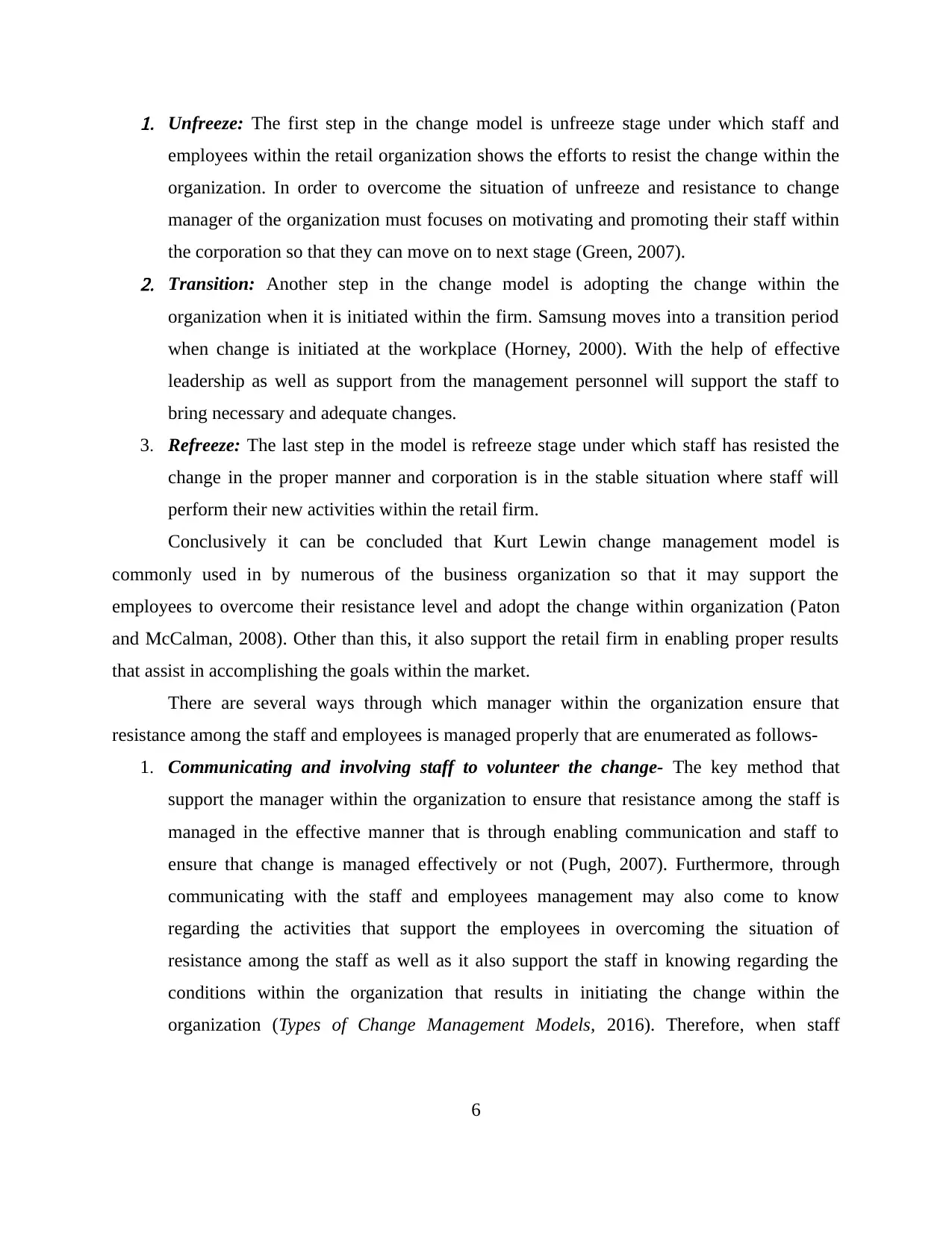
1. Unfreeze: The first step in the change model is unfreeze stage under which staff and
employees within the retail organization shows the efforts to resist the change within the
organization. In order to overcome the situation of unfreeze and resistance to change
manager of the organization must focuses on motivating and promoting their staff within
the corporation so that they can move on to next stage (Green, 2007).2. Transition: Another step in the change model is adopting the change within the
organization when it is initiated within the firm. Samsung moves into a transition period
when change is initiated at the workplace (Horney, 2000). With the help of effective
leadership as well as support from the management personnel will support the staff to
bring necessary and adequate changes.
3. Refreeze: The last step in the model is refreeze stage under which staff has resisted the
change in the proper manner and corporation is in the stable situation where staff will
perform their new activities within the retail firm.
Conclusively it can be concluded that Kurt Lewin change management model is
commonly used in by numerous of the business organization so that it may support the
employees to overcome their resistance level and adopt the change within organization (Paton
and McCalman, 2008). Other than this, it also support the retail firm in enabling proper results
that assist in accomplishing the goals within the market.
There are several ways through which manager within the organization ensure that
resistance among the staff and employees is managed properly that are enumerated as follows-
1. Communicating and involving staff to volunteer the change- The key method that
support the manager within the organization to ensure that resistance among the staff is
managed in the effective manner that is through enabling communication and staff to
ensure that change is managed effectively or not (Pugh, 2007). Furthermore, through
communicating with the staff and employees management may also come to know
regarding the activities that support the employees in overcoming the situation of
resistance among the staff as well as it also support the staff in knowing regarding the
conditions within the organization that results in initiating the change within the
organization (Types of Change Management Models, 2016). Therefore, when staff
6
employees within the retail organization shows the efforts to resist the change within the
organization. In order to overcome the situation of unfreeze and resistance to change
manager of the organization must focuses on motivating and promoting their staff within
the corporation so that they can move on to next stage (Green, 2007).2. Transition: Another step in the change model is adopting the change within the
organization when it is initiated within the firm. Samsung moves into a transition period
when change is initiated at the workplace (Horney, 2000). With the help of effective
leadership as well as support from the management personnel will support the staff to
bring necessary and adequate changes.
3. Refreeze: The last step in the model is refreeze stage under which staff has resisted the
change in the proper manner and corporation is in the stable situation where staff will
perform their new activities within the retail firm.
Conclusively it can be concluded that Kurt Lewin change management model is
commonly used in by numerous of the business organization so that it may support the
employees to overcome their resistance level and adopt the change within organization (Paton
and McCalman, 2008). Other than this, it also support the retail firm in enabling proper results
that assist in accomplishing the goals within the market.
There are several ways through which manager within the organization ensure that
resistance among the staff and employees is managed properly that are enumerated as follows-
1. Communicating and involving staff to volunteer the change- The key method that
support the manager within the organization to ensure that resistance among the staff is
managed in the effective manner that is through enabling communication and staff to
ensure that change is managed effectively or not (Pugh, 2007). Furthermore, through
communicating with the staff and employees management may also come to know
regarding the activities that support the employees in overcoming the situation of
resistance among the staff as well as it also support the staff in knowing regarding the
conditions within the organization that results in initiating the change within the
organization (Types of Change Management Models, 2016). Therefore, when staff
6
⊘ This is a preview!⊘
Do you want full access?
Subscribe today to unlock all pages.

Trusted by 1+ million students worldwide
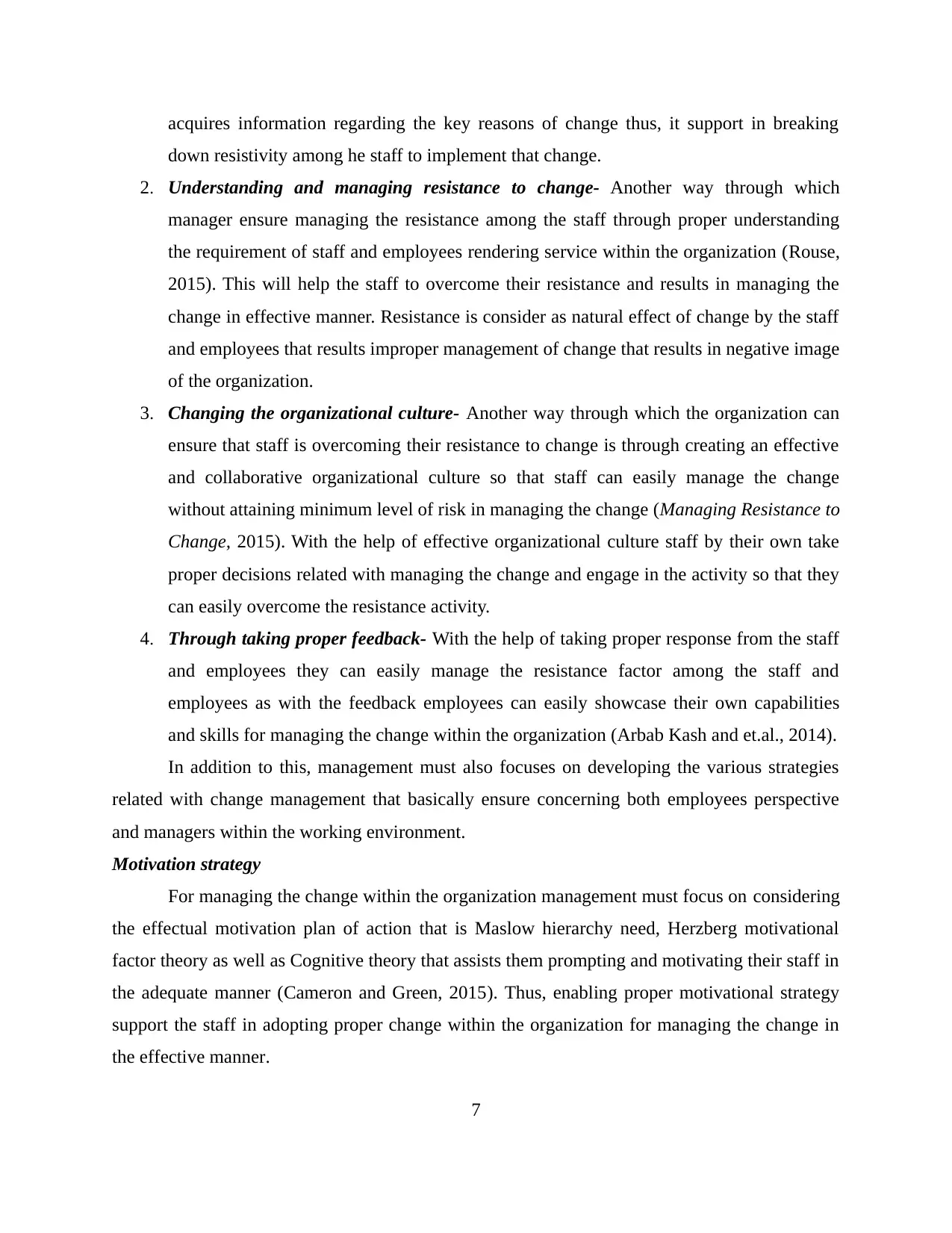
acquires information regarding the key reasons of change thus, it support in breaking
down resistivity among he staff to implement that change.
2. Understanding and managing resistance to change- Another way through which
manager ensure managing the resistance among the staff through proper understanding
the requirement of staff and employees rendering service within the organization (Rouse,
2015). This will help the staff to overcome their resistance and results in managing the
change in effective manner. Resistance is consider as natural effect of change by the staff
and employees that results improper management of change that results in negative image
of the organization.
3. Changing the organizational culture- Another way through which the organization can
ensure that staff is overcoming their resistance to change is through creating an effective
and collaborative organizational culture so that staff can easily manage the change
without attaining minimum level of risk in managing the change (Managing Resistance to
Change, 2015). With the help of effective organizational culture staff by their own take
proper decisions related with managing the change and engage in the activity so that they
can easily overcome the resistance activity.
4. Through taking proper feedback- With the help of taking proper response from the staff
and employees they can easily manage the resistance factor among the staff and
employees as with the feedback employees can easily showcase their own capabilities
and skills for managing the change within the organization (Arbab Kash and et.al., 2014).
In addition to this, management must also focuses on developing the various strategies
related with change management that basically ensure concerning both employees perspective
and managers within the working environment.
Motivation strategy
For managing the change within the organization management must focus on considering
the effectual motivation plan of action that is Maslow hierarchy need, Herzberg motivational
factor theory as well as Cognitive theory that assists them prompting and motivating their staff in
the adequate manner (Cameron and Green, 2015). Thus, enabling proper motivational strategy
support the staff in adopting proper change within the organization for managing the change in
the effective manner.
7
down resistivity among he staff to implement that change.
2. Understanding and managing resistance to change- Another way through which
manager ensure managing the resistance among the staff through proper understanding
the requirement of staff and employees rendering service within the organization (Rouse,
2015). This will help the staff to overcome their resistance and results in managing the
change in effective manner. Resistance is consider as natural effect of change by the staff
and employees that results improper management of change that results in negative image
of the organization.
3. Changing the organizational culture- Another way through which the organization can
ensure that staff is overcoming their resistance to change is through creating an effective
and collaborative organizational culture so that staff can easily manage the change
without attaining minimum level of risk in managing the change (Managing Resistance to
Change, 2015). With the help of effective organizational culture staff by their own take
proper decisions related with managing the change and engage in the activity so that they
can easily overcome the resistance activity.
4. Through taking proper feedback- With the help of taking proper response from the staff
and employees they can easily manage the resistance factor among the staff and
employees as with the feedback employees can easily showcase their own capabilities
and skills for managing the change within the organization (Arbab Kash and et.al., 2014).
In addition to this, management must also focuses on developing the various strategies
related with change management that basically ensure concerning both employees perspective
and managers within the working environment.
Motivation strategy
For managing the change within the organization management must focus on considering
the effectual motivation plan of action that is Maslow hierarchy need, Herzberg motivational
factor theory as well as Cognitive theory that assists them prompting and motivating their staff in
the adequate manner (Cameron and Green, 2015). Thus, enabling proper motivational strategy
support the staff in adopting proper change within the organization for managing the change in
the effective manner.
7
Paraphrase This Document
Need a fresh take? Get an instant paraphrase of this document with our AI Paraphraser
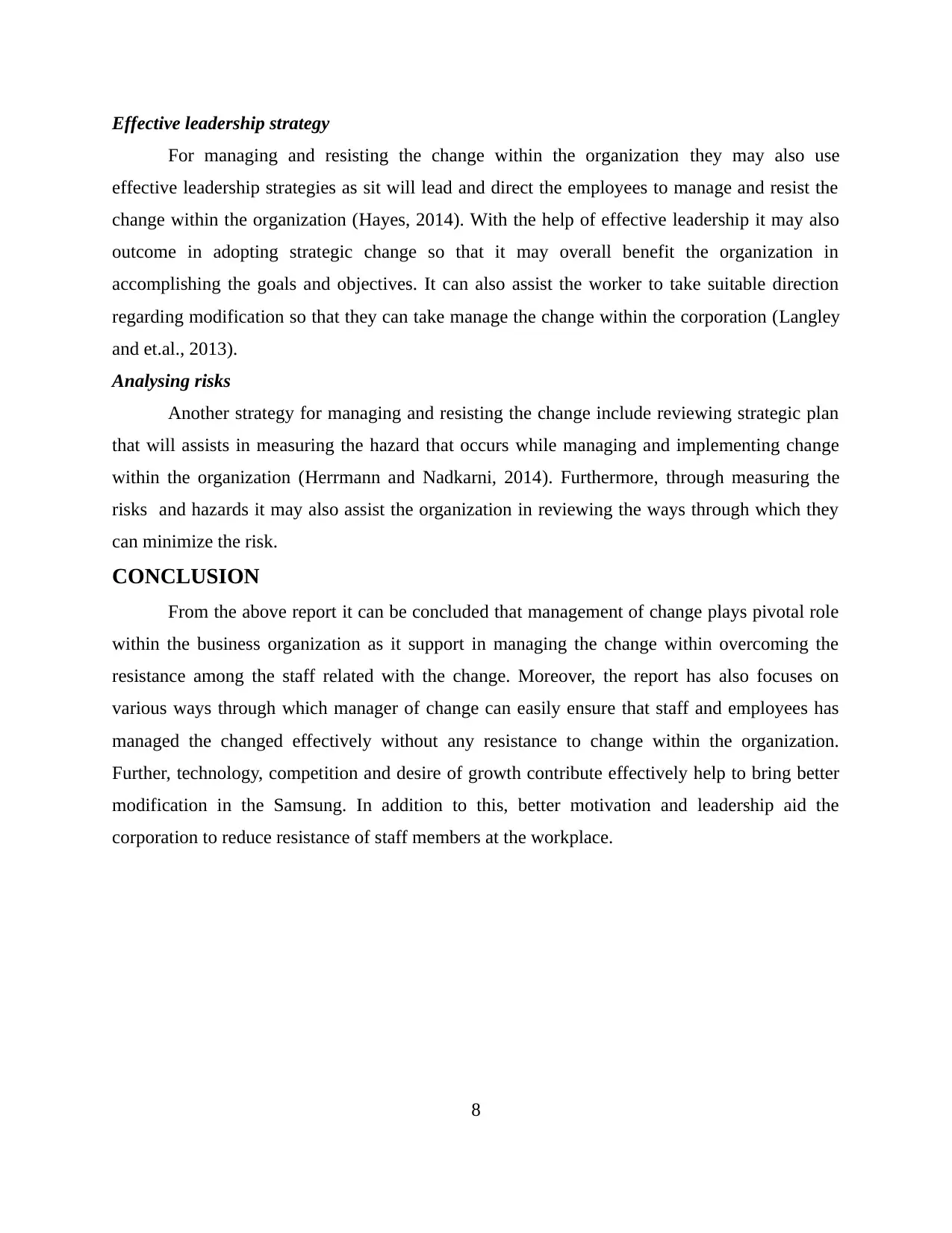
Effective leadership strategy
For managing and resisting the change within the organization they may also use
effective leadership strategies as sit will lead and direct the employees to manage and resist the
change within the organization (Hayes, 2014). With the help of effective leadership it may also
outcome in adopting strategic change so that it may overall benefit the organization in
accomplishing the goals and objectives. It can also assist the worker to take suitable direction
regarding modification so that they can take manage the change within the corporation (Langley
and et.al., 2013).
Analysing risks
Another strategy for managing and resisting the change include reviewing strategic plan
that will assists in measuring the hazard that occurs while managing and implementing change
within the organization (Herrmann and Nadkarni, 2014). Furthermore, through measuring the
risks and hazards it may also assist the organization in reviewing the ways through which they
can minimize the risk.
CONCLUSION
From the above report it can be concluded that management of change plays pivotal role
within the business organization as it support in managing the change within overcoming the
resistance among the staff related with the change. Moreover, the report has also focuses on
various ways through which manager of change can easily ensure that staff and employees has
managed the changed effectively without any resistance to change within the organization.
Further, technology, competition and desire of growth contribute effectively help to bring better
modification in the Samsung. In addition to this, better motivation and leadership aid the
corporation to reduce resistance of staff members at the workplace.
8
For managing and resisting the change within the organization they may also use
effective leadership strategies as sit will lead and direct the employees to manage and resist the
change within the organization (Hayes, 2014). With the help of effective leadership it may also
outcome in adopting strategic change so that it may overall benefit the organization in
accomplishing the goals and objectives. It can also assist the worker to take suitable direction
regarding modification so that they can take manage the change within the corporation (Langley
and et.al., 2013).
Analysing risks
Another strategy for managing and resisting the change include reviewing strategic plan
that will assists in measuring the hazard that occurs while managing and implementing change
within the organization (Herrmann and Nadkarni, 2014). Furthermore, through measuring the
risks and hazards it may also assist the organization in reviewing the ways through which they
can minimize the risk.
CONCLUSION
From the above report it can be concluded that management of change plays pivotal role
within the business organization as it support in managing the change within overcoming the
resistance among the staff related with the change. Moreover, the report has also focuses on
various ways through which manager of change can easily ensure that staff and employees has
managed the changed effectively without any resistance to change within the organization.
Further, technology, competition and desire of growth contribute effectively help to bring better
modification in the Samsung. In addition to this, better motivation and leadership aid the
corporation to reduce resistance of staff members at the workplace.
8
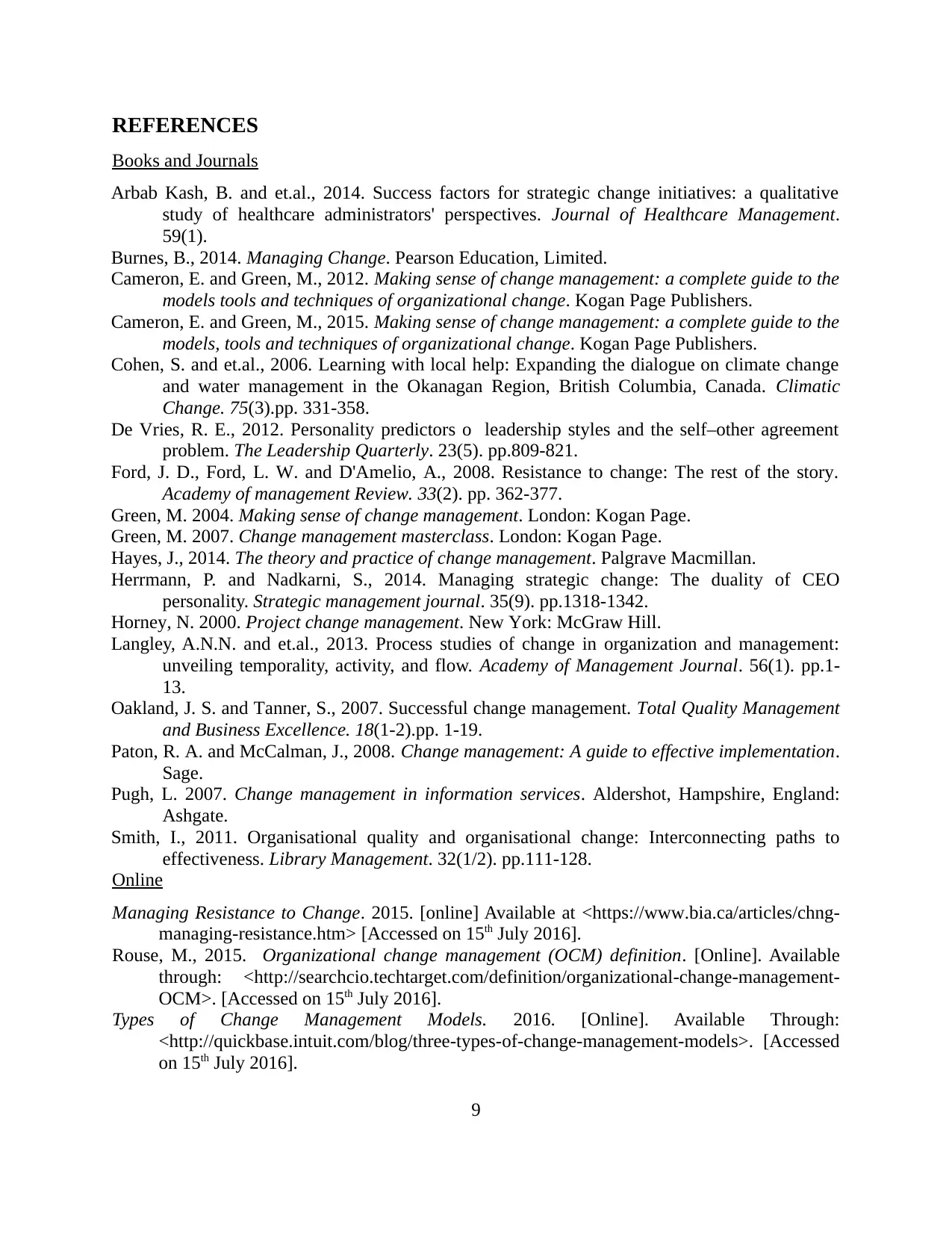
REFERENCES
Books and Journals
Arbab Kash, B. and et.al., 2014. Success factors for strategic change initiatives: a qualitative
study of healthcare administrators' perspectives. Journal of Healthcare Management.
59(1).
Burnes, B., 2014. Managing Change. Pearson Education, Limited.
Cameron, E. and Green, M., 2012. Making sense of change management: a complete guide to the
models tools and techniques of organizational change. Kogan Page Publishers.
Cameron, E. and Green, M., 2015. Making sense of change management: a complete guide to the
models, tools and techniques of organizational change. Kogan Page Publishers.
Cohen, S. and et.al., 2006. Learning with local help: Expanding the dialogue on climate change
and water management in the Okanagan Region, British Columbia, Canada. Climatic
Change. 75(3).pp. 331-358.
De Vries, R. E., 2012. Personality predictors o leadership styles and the self–other agreement
problem. The Leadership Quarterly. 23(5). pp.809-821.
Ford, J. D., Ford, L. W. and D'Amelio, A., 2008. Resistance to change: The rest of the story.
Academy of management Review. 33(2). pp. 362-377.
Green, M. 2004. Making sense of change management. London: Kogan Page.
Green, M. 2007. Change management masterclass. London: Kogan Page.
Hayes, J., 2014. The theory and practice of change management. Palgrave Macmillan.
Herrmann, P. and Nadkarni, S., 2014. Managing strategic change: The duality of CEO
personality. Strategic management journal. 35(9). pp.1318-1342.
Horney, N. 2000. Project change management. New York: McGraw Hill.
Langley, A.N.N. and et.al., 2013. Process studies of change in organization and management:
unveiling temporality, activity, and flow. Academy of Management Journal. 56(1). pp.1-
13.
Oakland, J. S. and Tanner, S., 2007. Successful change management. Total Quality Management
and Business Excellence. 18(1-2).pp. 1-19.
Paton, R. A. and McCalman, J., 2008. Change management: A guide to effective implementation.
Sage.
Pugh, L. 2007. Change management in information services. Aldershot, Hampshire, England:
Ashgate.
Smith, I., 2011. Organisational quality and organisational change: Interconnecting paths to
effectiveness. Library Management. 32(1/2). pp.111-128.
Online
Managing Resistance to Change. 2015. [online] Available at <https://www.bia.ca/articles/chng-
managing-resistance.htm> [Accessed on 15th July 2016].
Rouse, M., 2015. Organizational change management (OCM) definition. [Online]. Available
through: <http://searchcio.techtarget.com/definition/organizational-change-management-
OCM>. [Accessed on 15th July 2016].
Types of Change Management Models. 2016. [Online]. Available Through:
<http://quickbase.intuit.com/blog/three-types-of-change-management-models>. [Accessed
on 15th July 2016].
9
Books and Journals
Arbab Kash, B. and et.al., 2014. Success factors for strategic change initiatives: a qualitative
study of healthcare administrators' perspectives. Journal of Healthcare Management.
59(1).
Burnes, B., 2014. Managing Change. Pearson Education, Limited.
Cameron, E. and Green, M., 2012. Making sense of change management: a complete guide to the
models tools and techniques of organizational change. Kogan Page Publishers.
Cameron, E. and Green, M., 2015. Making sense of change management: a complete guide to the
models, tools and techniques of organizational change. Kogan Page Publishers.
Cohen, S. and et.al., 2006. Learning with local help: Expanding the dialogue on climate change
and water management in the Okanagan Region, British Columbia, Canada. Climatic
Change. 75(3).pp. 331-358.
De Vries, R. E., 2012. Personality predictors o leadership styles and the self–other agreement
problem. The Leadership Quarterly. 23(5). pp.809-821.
Ford, J. D., Ford, L. W. and D'Amelio, A., 2008. Resistance to change: The rest of the story.
Academy of management Review. 33(2). pp. 362-377.
Green, M. 2004. Making sense of change management. London: Kogan Page.
Green, M. 2007. Change management masterclass. London: Kogan Page.
Hayes, J., 2014. The theory and practice of change management. Palgrave Macmillan.
Herrmann, P. and Nadkarni, S., 2014. Managing strategic change: The duality of CEO
personality. Strategic management journal. 35(9). pp.1318-1342.
Horney, N. 2000. Project change management. New York: McGraw Hill.
Langley, A.N.N. and et.al., 2013. Process studies of change in organization and management:
unveiling temporality, activity, and flow. Academy of Management Journal. 56(1). pp.1-
13.
Oakland, J. S. and Tanner, S., 2007. Successful change management. Total Quality Management
and Business Excellence. 18(1-2).pp. 1-19.
Paton, R. A. and McCalman, J., 2008. Change management: A guide to effective implementation.
Sage.
Pugh, L. 2007. Change management in information services. Aldershot, Hampshire, England:
Ashgate.
Smith, I., 2011. Organisational quality and organisational change: Interconnecting paths to
effectiveness. Library Management. 32(1/2). pp.111-128.
Online
Managing Resistance to Change. 2015. [online] Available at <https://www.bia.ca/articles/chng-
managing-resistance.htm> [Accessed on 15th July 2016].
Rouse, M., 2015. Organizational change management (OCM) definition. [Online]. Available
through: <http://searchcio.techtarget.com/definition/organizational-change-management-
OCM>. [Accessed on 15th July 2016].
Types of Change Management Models. 2016. [Online]. Available Through:
<http://quickbase.intuit.com/blog/three-types-of-change-management-models>. [Accessed
on 15th July 2016].
9
⊘ This is a preview!⊘
Do you want full access?
Subscribe today to unlock all pages.

Trusted by 1+ million students worldwide
1 out of 9
Related Documents
Your All-in-One AI-Powered Toolkit for Academic Success.
+13062052269
info@desklib.com
Available 24*7 on WhatsApp / Email
![[object Object]](/_next/static/media/star-bottom.7253800d.svg)
Unlock your academic potential
Copyright © 2020–2025 A2Z Services. All Rights Reserved. Developed and managed by ZUCOL.





